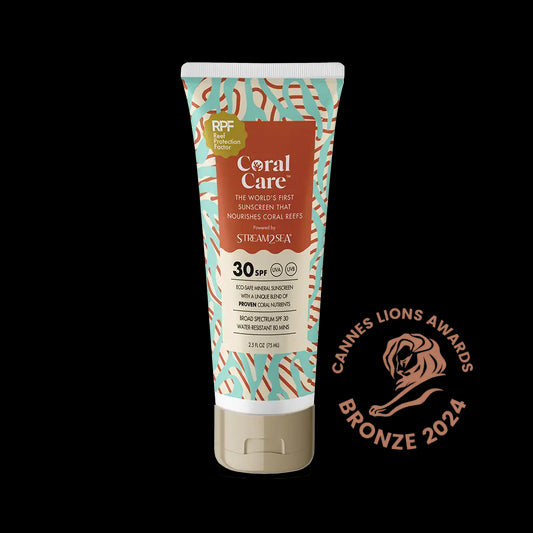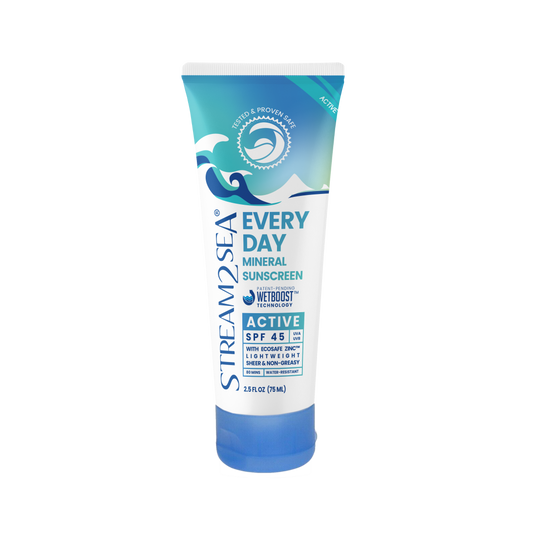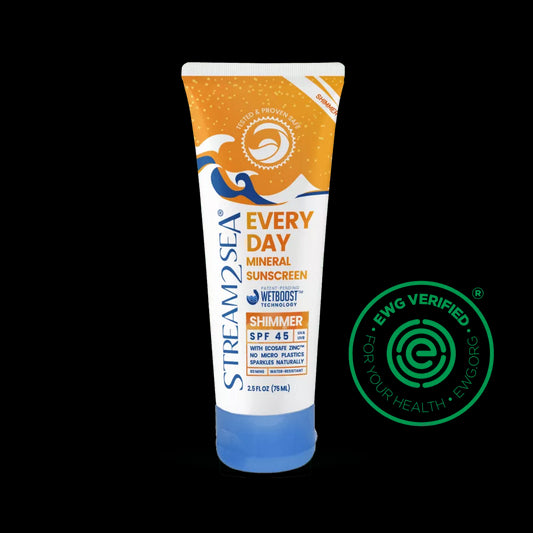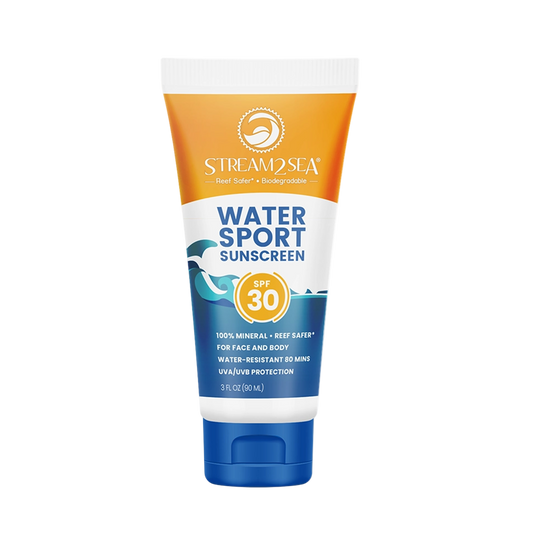Share
Are you worried about sharks in the ocean? I’m here to say you should be more afraid of what’s lurking in your local swimming pool – especially if you and other swimmers are slathered in chemical sunscreens.
I’ve been cautioning against using petrochemical sunscreens in our lakes and oceans, but it turns out that ingredients like avobenzone and octocrylene don’t play nice with chlorine either. In fact, study after study (links below for those of us who need the facts) shows that many petrochemical sunscreen ingredients don’t just degrade in chlorinated water and sunlight, they transform into even more toxic byproducts. It’s not just bad chemistry; it’s a recipe for a toxic soup that you may be swimming in.
Reef Safer Is Also Pool Safer
A recent report published in Chemosphere found that when avobenzone – hidden even in many ‘mineral’ sunscreens -is exposed to chlorine, it mutates into a toxic cocktail of byproducts, including aromatic acids, aldehydes, phenols, and acetyl benzenes. According to lead researcher Albert Lebedev, “a generally safe compound transforms in the water and forms more dangerous products.”
Chemical Chaos: Dozens of Byproducts in Pool Water
I personally question the statement that avobenzone is “generally safe” to begin with, but absolutely agree on the second part. Once it hits the pool, avobenzone turns sinister.
Another study published in Environmental International found over 60 different chemical byproducts created by the breakdown of avobenzone in chlorinated water. Among these, chlorinated phenols and acetophenones, both known for their toxicity and definitely not something you want swirling around in your kid’s swim goggles.
- Chlorinated phenols are likely to cause skin irritation; severe exposure may cause weakness, muscle aches and pain, or even liver and kidney damage or convulsions.
- Bromine and related chemical compounds are naturally occurring, but chronic or acute exposure may cause disturbances of the respiratory, nervous and endocrine systems.
- When exposed to chlorine, oxybenzone caused significantly more cell death in test tubes than unchlorinated controls.
If It’s Not Safe for Reefs, It’s Not Safe for Pools
We’ve encouraged people to avoid petrochemical sunscreens since 2015, even before Dr. Craig Down’s landmark study showing that oxybenzone kills coral in minute concentrations. As concerned as he is about coral reefs, he won’t allow his young children to swim in public pools where chlorine and UV radiation combine to create even more toxic compounds.
But there is good news: Stream2Sea’s mineral sunscreens are made with coated non-nano zinc oxide and titanium dioxide NOT petrochemicals, and haven’t been shown to react with other substances in swimming pools.
Try This Swimming Pool Safe Sunscreen
“The toxicity and pollution in swimming pools are much, much worse than what we see on coral reefs,” said Dr. Downs. “Not only are the sunscreen ingredients more concentrated in a swimming pool, but the disinfectants like chlorine oxidize oxybenzone and avobenzone and can increase their toxicity by 600% and more. That makes these oxidized sunscreens more genotoxic, mutagenic and carcinogenic.”
Dermatologists Are Taking Notice
“It’s certainly alarming,” University of Kansas dermatologist Daniel Ayers told the Kansas City Star. “(Avobenzone) can degrade into some very harmful compounds, some of which are known carcinogens. What isn’t known is how much is absorbed into the skin, or if it’s to a level that can cause, or potentially increase, the risk of cancer.”
What we do know is this: these chemical sunscreen ingredients are absorbed through your skin and end up in your bloodstream. The FDA thought that was concerning enough to pull their “Generally Recognized As Safe and Effective” (GRASE) status in 2020, after their own clinical trials confirmed that active ingredients are systemically absorbed—even with normal use.
It Doesn’t End at the Pool
Even after you rinse off, those petrochemical residues don’t just vanish. Wastewater treatment plants aren't equipped to filter them out, which means they’re discharged into rivers, lakes, and reservoirs. From there, they’re often chlorinated and—you guessed it—make their way right back to your tap. Refreshing, right?
As I wrap up this terrifying tale of toxic swimming pools, let me leave you with a comforting thought: you're statistically more likely to be injured in a car accident on the way to the beach than to have a run-in with a shark. I’ve been diving with sharks for decades—from the reefs of Florida to the wild waters of the Galápagos—and trust me, I feel far safer in the open ocean than I do in a chlorinated public pool.
Doesn’t this tell us that it’s time to consider safer alternatives? At Stream2Sea, we consciously formulate non-nano mineral sunscreens with naturally occurring ingredients that do not break down into harmful substances when exposed to chlorine.

Wishing you clear water, strong science, and safer swims — for you and the planet. Stay bold. Stay reef safer. 🌊
— Autumn Blum, Cosmetic Chemist & CEO, Stream2Sea
Shop Our Swimming Pool Safe Sunscreens
References:
Journal of Cosmetic Dermatology, Dermatological and environmental toxicological impact of the sunscreen ingredient oxybenzone/benzophenone-3
Cutaneous and Ocular Toxicology, Altered UV absorbance and cytotoxicity of chlorinated sunscreen agents.
Environment International, Chemical contaminants in swimming pools: Occurrence, implications and control.
Journal of Environmental Sciences, Occurrence and formation of disinfection by-products in the swimming pool environment: A critical review.
Molecules, Environmental Fate of Organic Sunscreens during Water Disinfection Processes: The Formation of Degradation By-Products and Their Toxicological Profiles.
Water Research, Transformation of avobenzone in conditions of aquatic chlorination and UV-irradiation.
Environment International, Identification of avobenzone by-products formed by various disinfectants in different types of swimming pool waters.
Journal of the American Medical Association, Effect of Sunscreen Application on Plasma Concentration of Sunscreen Active Ingredients, A Randomized Clinical Trial.
![[S2S] After-sun Care](http://stream2sea.com/cdn/shop/collections/SPF30_and_Sun_Sting_Gel.jpg?v=1764789810&width=1500)








